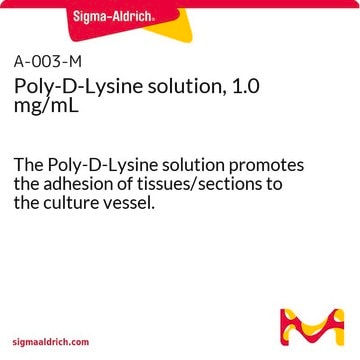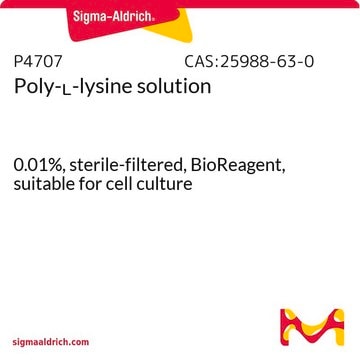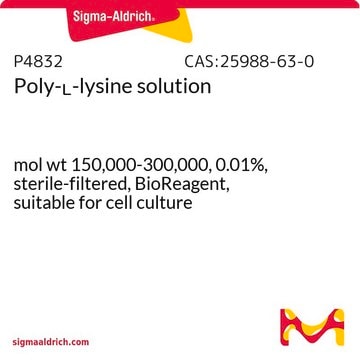If this product has an expiration or retest date, it will be shown on the Certificate of Analysis (COA, CofA). If there is no retest or expiration date listed on the product's COA, we do not have suitable stability data to determine a shelf life. For these products, the only date on the COA will be the release date; a retest, expiration, or use-by-date will not be displayed.
For all products, we recommend handling per defined conditions as printed in our product literature and website product descriptions. We recommend that products should be routinely inspected by customers to ensure they perform as expected.
For products without retest or expiration dates, our standard warranty of 1 year from the date of shipment is applicable.
For more information, please refer to the Product Dating Information document: https://www.sigmaaldrich.com/deepweb/assets/sigmaaldrich/marketing/global/documents/449/386/product-dating-information-mk.pdf
P0899
Poly-D-lysine hydrobromide
suitable for cell culture, Mol wt 70,000-150,000
Synonym(s):
D-Lysine homopolymer hydrobromide
Select a Size
Select a Size
About This Item
Recommended Products
Product Name
Poly-D-lysine hydrobromide, mol wt 70,000-150,000
form
solid
Quality Level
mol wt
70,000-150,000
technique(s)
cell culture | mammalian: suitable
impurities
<10% water (Karl Fischer)
color
white to off-white
solubility
water: 50 mg/mL, clear, colorless to very faintly yellow
functional group
amide
storage temp.
−20°C
SMILES string
O=C(C)[C@@](NC)([H])CCCCN.[Br]
InChI
1S/C6H14N2O2.BrH/c7-4-2-1-3-5(8)6(9)10;/h5H,1-4,7-8H2,(H,9,10);1H
InChI key
MEXAGTSTSPYCEP-UHFFFAOYSA-N
Looking for similar products? Visit Product Comparison Guide
General description
Application
- Used in animal cell culture[1]
- Rat cortical neuron cultures[2]
- Cell culture and siRNA treatment[3]
- Primary cell cultures and adult neuronal network model[4]
- Cortical astrocyte culture[5]
- Immunofluorescence staining (HDF cells were plated onto poly-D lysine (P0899, Sigma-Aldrich) coated glass coverslips)[6]
- NPC collection and culture conditions[7]
This product is recommended as a cell culture substratum when using 0.5 - 1.0 mL of a 0.1 mg/mL solution to coat 25 cm2. Lower molecular weight versions of the product are less viscous, but high more molecular weight versions provide more attachment sites per molecule.
Biochem/physiol Actions
Features and Benefits
- Suitable for Cell Culture and Biochemical research
- High-quality compound suitable for multiple research applications
Components
Caution
Analysis Note
Other Notes
comparable product
Storage Class Code
11 - Combustible Solids
WGK
WGK 3
Flash Point(F)
Not applicable
Flash Point(C)
Not applicable
Personal Protective Equipment
Choose from one of the most recent versions:
Certificates of Analysis (COA)
Don't see the Right Version?
If you require a particular version, you can look up a specific certificate by the Lot or Batch number.
Already Own This Product?
Find documentation for the products that you have recently purchased in the Document Library.
Customers Also Viewed
Articles
Humankind has utilized protein materials throughout its existence, starting with the use of materials such as wool and silk for warmth and protection from the elements and continuing with the use of recombinant DNA techniques to synthesize proteins with unique and useful properties.
-
How can I determine the shelf life / expiration / retest date of this product?
1 answer-
Helpful?
-
-
How is shipping temperature determined? And how is it related to the product storage temperature?
1 answer-
Products may be shipped at a different temperature than the recommended long-term storage temperature. If the product quality is sensitive to short-term exposure to conditions other than the recommended long-term storage, it will be shipped on wet or dry-ice. If the product quality is NOT affected by short-term exposure to conditions other than the recommended long-term storage, it will be shipped at ambient temperature. As shipping routes are configured for minimum transit times, shipping at ambient temperature helps control shipping costs for our customers. For more information, please refer to the Storage and Transport Conditions document: https://www.sigmaaldrich.com/deepweb/assets/sigmaaldrich/marketing/global/documents/316/622/storage-transport-conditions-mk.pdf
Helpful?
-
Active Filters
Our team of scientists has experience in all areas of research including Life Science, Material Science, Chemical Synthesis, Chromatography, Analytical and many others.
Contact Technical Service







